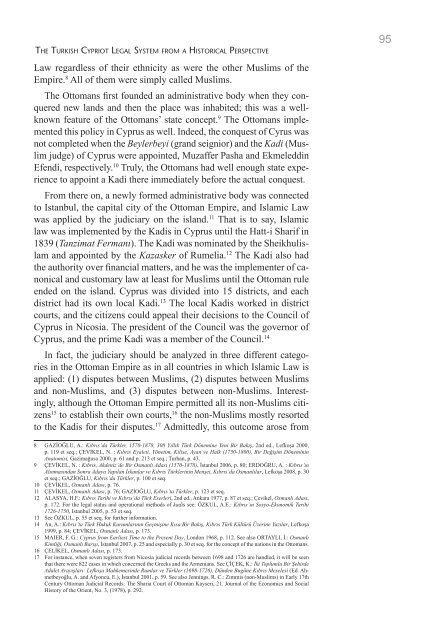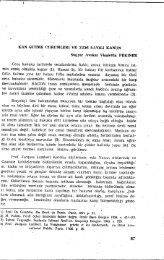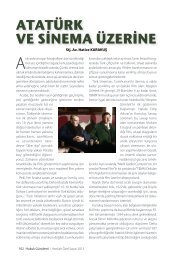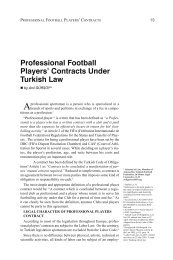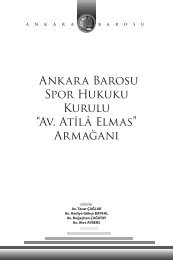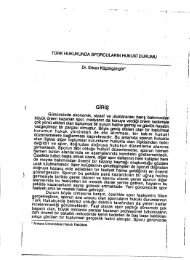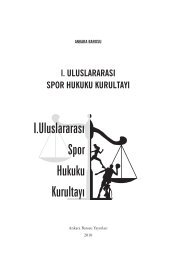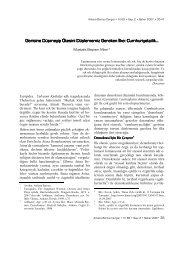The Turkish Cypriot Legal System from a Historical ... - Ankara Barosu
The Turkish Cypriot Legal System from a Historical ... - Ankara Barosu
The Turkish Cypriot Legal System from a Historical ... - Ankara Barosu
You also want an ePaper? Increase the reach of your titles
YUMPU automatically turns print PDFs into web optimized ePapers that Google loves.
<strong>The</strong> TuRkish CypRioT legal sysTem fRom a hisToRiCal peRspeCTiVe<br />
Law regardless of their ethnicity as were the other Muslims of the<br />
Empire. 8 All of them were simply called Muslims.<br />
<strong>The</strong> Ottomans first founded an administrative body when they conquered<br />
new lands and then the place was inhabited; this was a wellknown<br />
feature of the Ottomans’ state concept. 9 <strong>The</strong> Ottomans implemented<br />
this policy in Cyprus as well. Indeed, the conquest of Cyrus was<br />
not completed when the Beylerbeyi (grand seignior) and the Kadi (Muslim<br />
judge) of Cyprus were appointed, Muzaffer Pasha and Ekmeleddin<br />
Efendi, respectively. 10 Truly, the Ottomans had well enough state experience<br />
to appoint a Kadi there immediately before the actual conquest.<br />
From there on, a newly formed administrative body was connected<br />
to Istanbul, the capital city of the Ottoman Empire, and Islamic Law<br />
was applied by the judiciary on the island. 11 That is to say, Islamic<br />
law was implemented by the Kadis in Cyprus until the Hatt-i Sharif in<br />
1839 (Tanzimat Fermanı). <strong>The</strong> Kadi was nominated by the Sheikhulislam<br />
and appointed by the Kazasker of Rumelia. 12 <strong>The</strong> Kadi also had<br />
the authority over financial matters, and he was the implementer of canonical<br />
and customary law at least for Muslims until the Ottoman rule<br />
ended on the island. Cyprus was divided into 15 districts, and each<br />
district had its own local Kadi. 13 <strong>The</strong> local Kadis worked in district<br />
courts, and the citizens could appeal their decisions to the Council of<br />
Cyprus in Nicosia. <strong>The</strong> president of the Council was the governor of<br />
Cyprus, and the prime Kadi was a member of the Council. 14<br />
In fact, the judiciary should be analyzed in three different categories<br />
in the Ottoman Empire as in all countries in which Islamic Law is<br />
applied: (1) disputes between Muslims, (2) disputes between Muslims<br />
and non-Muslims, and (3) disputes between non-Muslims. Interestingly,<br />
although the Ottoman Empire permitted all its non-Muslims citizens<br />
15 to establish their own courts, 16 the non-Muslims mostly resorted<br />
to the Kadis for their disputes. 17 Admittedly, this outcome arose <strong>from</strong><br />
8 GAZİOĞLU, A.: Kıbrıs’da Türkler, 1570-1878, 308 Yıllık Türk Dönemine Yeni Bir Bakış, 2nd ed., Lefkoşa 2000,<br />
p. 119 et seq.; ÇEVİKEL, N. : Kıbrıs Eyaleti, Yönetim, Kilise, Ayan ve Halk (1750-1800), Bir Değişim Döneminin<br />
Anatomisi, Gazimağusa 2000, p. 61 and p. 213 et seq.; Turhan, p. 43.<br />
9 ÇEVİKEL, N. : Kıbrıs, Akdeniz’de Bir Osmanlı Adası (1570-1878), İstanbul 2006, p. 80; ERDOĞRU, A. : Kıbrıs’ın<br />
Alınmasından Sonra Adaya Yapılan İskanlar ve Kıbrıs Türklerinin Menşei, Kıbrıs’da Osmanlılar, Lefkoşa 2008, p. 30<br />
et seq.; GAZİOĞLU, Kıbrıs’da Türkler, p. 100 et seq.<br />
10 ÇEVİKEL, Osmanlı Adası, p. 76.<br />
11 ÇEVİKEL, Osmanlı Adası, p. 76; GAZİOĞLU, Kıbrıs’ta Türkler, p. 123 et seq.<br />
12 ALASYA, H.F.: Kıbrıs Tarihi ve Kıbrıs’da Türk Eserleri, 2nd ed., <strong>Ankara</strong> 1977, p. 87 et seq.; Çevikel, Osmanlı Adası,<br />
p. 172. For the legal status and operational methods of kadis see: ÖZKUL, A.E.: Kıbrıs’ın Sosyo-Ekonomik Tarihi<br />
1726-1750, Istanbul 2005, p. 53 et seq.<br />
13 See ÖZKUL, p. 55 et seq. for further information.<br />
14 An, A.: Kıbrıs’ta Türk Hukuk Kurumlarının Geçmişine Kısa Bir Bakış, Kıbrıs Türk Kültürü Üzerine Yazılar, Lefkoşa<br />
1999, p. 84; ÇEVİKEL, Osmanlı Adası, p. 173.<br />
15 MAIER, F. G.: Cyprus <strong>from</strong> Earliest Time to the Present Day, London 1968, p. 112. See also ORTAYLI, İ.: Osmanlı<br />
Kimliği, Osmanlı Barışı, İstanbul 2007, p. 25 and especially p. 30 et seq. for the concept of the nations in the Ottomans.<br />
16 ÇELİKEL, Osmanlı Adası, p. 173.<br />
17 For instance, when seven registers <strong>from</strong> Nicosia judicial records between 1698 and 1726 are handled, it will be seen<br />
that there were 822 cases in which concerned the Greeks and the Armenians. See ÇİÇEK, K.: İki Toplumlu Bir Şehirde<br />
Adalet Arayışları: Lefkoşa Mahkemesinde Rumlar ve Türkler (1698-1726), Dünden Bugüne Kıbrıs Meselesi (Ed. Ahmetbeyoğlu,<br />
A. and Afyoncu, E.), İstanbul 2001, p. 59. See also Jennings, R. C.: Zımmis (non-Muslims) in Early 17th<br />
Century Ottoman Judicial Records: <strong>The</strong> Sharia Court of Ottoman Kayseri, 21. Journal of the Economics and Social<br />
History of the Orient, No. 3, (1978), p. 292.<br />
95


